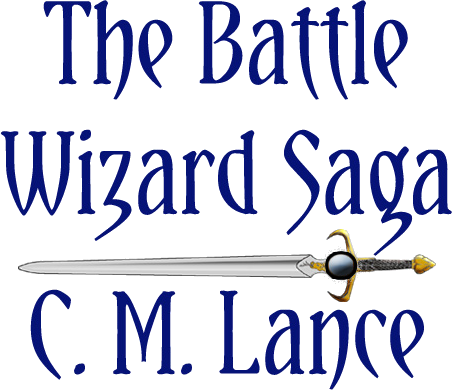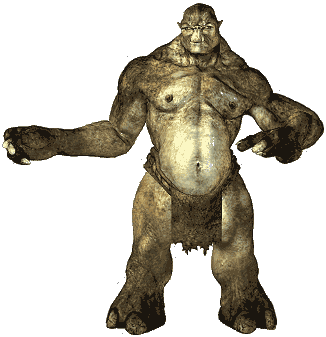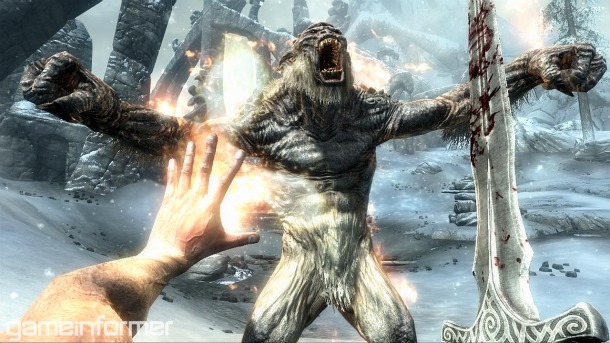 |

Mountain Troll |
TrollsSig has run-ins with Dmitry, part troll and part human. Later he is kidnapped and held hostage by Dmitry's brothers, full blooded trolls. He eventually wins his freedom from the trolls. Trolls A troll is a supernatural being in Norse mythology and Scandinavian folklore. In origin, the term troll was a generally negative synonym for a jötunn (plural jötnar), a being in Norse mythology. In Old Norse sources, beings described as trolls dwell in isolated rocks, mountains, or caves, live together in small family units, and are rarely helpful to human beings.
In Scandinavian folklore,
depending on the region from which accounts of trolls stem,
their appearance varies greatly; trolls may be ugly and
slow-witted or look and behave exactly like human beings,
with no particularly grotesque characteristic about them.
Trolls are sometimes associated with particular landmarks,
which at times may be explained as formed from a troll
exposed to sunlight. Trolls are often tall, lanky, and muscular. They have both elven and orcish characteristics with their fierce fangs and long ears. Their long arms, strong legs and quick reflexes make them adept hunters. They are often described as having two fingers and a thumb and only two toes. Forest trolls' bodies can support plant life to a limited extent due to a mutation that took place many millennia ago. A thin layer of moss will inevitably grow on the skin of a forest troll shortly after they are born, giving them their characteristic green coloring. Their moss-like skin color ranges from light green to blue and purple. However, the jungle trolls' bodies are covered in a short, soft fur which cause the trolls to appear purple or gray. Mountain trolls are often described as hairless or with patches of hair sprouting randomly from otherwise hairless bodies, particularly notable are clumps of hair growing from noses, ears, fingers and hands, and fringing their pates. Although enough physical damage will kill them, trolls can regenerate lost limbs and heal grievous physical injuries at an accelerated rate, giving them a large advantage in battle. Trolls are so well known for their regenerative abilities that alchemical mixtures, which induce regeneration in other races, are referred to as "troll's blood potions," despite not actually containing any troll blood. Militant tribes of trolls are efficient killers and have a strong lust for blood. Some may still cling to their heritage of cannibalism and voodoo. In Norse mythology, trolls are mentioned throughout the Old Norse corpus. In Old Norse sources, trolls are said to dwell in isolated mountains, rocks, and caves, sometimes live together (usually as father-and-daughters or mother-and-sons), and are rarely described as helpful or friendly. In Scandinavian folklore, numerous tales about trolls are recorded. in which they are frequently described as being extremely old, very strong, but slow and dim-witted, and are at times described as man-eaters and as turning to stone upon contact with sunlight. However, trolls generally have "some form of social organization". Trolls display a habit of bergtagning ('kidnapping'; literally "mountain-taking") and overrunning a farm or estate. While noting that the etymology of the word "troll" remains uncertain, trolls are defined in later Swedish folklore as "nature beings" and as "ll-purpose otherworldly beings, equivalent, for example, to fairies in Anglo-Celtic traditions and that they therefore appear in various migratory legends where collective nature-beings are called for. A Scandinavian folk
belief that lightning frightens away trolls and jötnar
appears in numerous Scandinavian folktales, and may be a
late reflection of the god Thor's role in fighting such
beings. In connection, the lack of trolls and jötnar in
modern Scandinavia is sometimes explained as a result of the
"accuracy and efficiency of the lightning strokes".
Additionally, the absence of trolls in regions of
Scandinavia are described in folklore as being a
"consequence of the constant din of the church-bells". This
Smaller trolls are attested as living in burial mounds and in mountains in Scandinavian folk tradition. In Denmark, these creatures are recorded as troldfolk ("troll-folk"), bjergtrolde ("mountain-trolls"), or bjergfolk ("mountain-folk") and in Norway also as troldfolk ("troll-folk") and tusser. Trolls may be described as small, human-like beings or much taller than men depending on the region of origin of the story. James MacCulloch theorizes a connection between the Old Norse vættir and trolls, theorizing that both concepts may either stem from (or ultimately derive from) spirits of the dead. In Norwegian tradition, similar tales may be told about the larger trolls and the Huldrefolk ("hidden-folk") yet a distinction is made between the two. The use of the word trow in Orkney and Shetland (alternatively trowe or drow), to mean beings which are very like the Huldrefolk in Norway, strongly suggests a common origin for the terms. The word troll may have been used by pagan Norse settlers in Orkney and Shetland as a collective term for supernatural beings who should be respected and avoided rather than worshiped. Troll could later have become specialized as a description of the larger, more menacing Jötunn-kind whereas Huldrefolk may have developed as the general term applied to smaller trolls.
|

 ring caused the trolls
to leave for other lands, although not without some
resistance; numerous traditions relate how trolls destroyed
a church under construction or tossed boulders or stones at
completed churches. Large local stones are sometimes
described as the product of a troll's toss. Additionally,
into the 20th century, the origins of particular
Scandinavian landmarks, such as particular stones, are
ascribed to trolls who may, for example, have turned to
stone upon exposure to sunlight.
ring caused the trolls
to leave for other lands, although not without some
resistance; numerous traditions relate how trolls destroyed
a church under construction or tossed boulders or stones at
completed churches. Large local stones are sometimes
described as the product of a troll's toss. Additionally,
into the 20th century, the origins of particular
Scandinavian landmarks, such as particular stones, are
ascribed to trolls who may, for example, have turned to
stone upon exposure to sunlight.